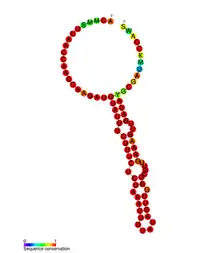| HSR omega conserved region 1 | |
|---|---|
 Conserved secondary structure of HSR-omega 1 | |
| Identifiers | |
| Symbol | HSR omega 1 |
| Rfam | RF01885 |
| Other data | |
| RNA type | Gene |
| PDB structures | PDBe |
The developmentally active and heat shock inducible hsromega or hsrω gene in Drosophila produces multiple long non-coding RNA transcripts. This gene is transcriptionally active in almost all cell types of Drosophila and is the most actively induced following heat shock. A unique feature of the hsromega gene, which led to discovery of the 93D puff in 1970, is its singular inducibility with benzamide and a variety of other amides.
The multiple transcripts of this gene include a nuclear >10kb long nuclear transcript, hsromega-n, and a 1.9kb nuclear transcript which after splicing produces a 1.2kb cytoplasmic transcript. The >10kb nuclear hsromega-n transcript organizes the nucleoplasmic omega speckles with which heterogeneous nuclear RNA-binding proteins (hnRNPs) and certain other proteins co-localize. The omega speckles are suggested to act as storage sites for hnRNPs etc. which are not actively engaged at a given time.[1]
The genomic architecture of this gene and hnRNP-binding properties of its large nuclear transcript are conserved in different species although the primary base sequence has diverged rapidly. Heat shock causes the omega speckles to disappear and all the omega speckle associated proteins and the hsrω-n transcript to accumulate at the 93D locus. The hsrω-n transcript directly or indirectly affects the localization/stability/activity of a variety of proteins including hnRNPs, Sxl, Hsp83, cAMP response element binding binding protein (CBP), Drosophila inhibitor of apoptosis protein 1 (DIAP1), JNK-signalling members, proteasome constituents, lamin C, ISWI, HP1 and poly(ADP)-ribose polymerase. In view of the interactions of this large nuclear non-coding RNA with diverse regulatory proteins, it appears to act as a hub that integrates multiple regulatory networks in the cell.[2][3][4]
References
- ↑ Prasanth KV, Rajendra TK, Lal AK, Lakhotia SC (October 2000). "Omega speckles — a novel class of nuclear speckles containing hnRNPs associated with noncoding hsr-omega RNA in Drosophila". Journal of Cell Science. 113 (19): 3485–3497. doi:10.1242/jcs.113.19.3485. PMID 10984439.
- ↑ Mallik M, Lakhotia SC (November 2009). "The developmentally active and stress-inducible noncoding hsrω gene is a novel regulator of apoptosis in Drosophila". Genetics. 183 (3): 831–852. doi:10.1534/genetics.109.108571. PMC 2778980. PMID 19737742.
- ↑ Mallik M, Lakhotia SC (April 2010). "Improved activities of CREB binding protein, heterogeneous nuclear ribonucleoproteins and proteasome following downregulation of noncoding hsrω transcripts help suppress poly(Q) pathogenesis in fly models". Genetics. 184 (4): 927–945. doi:10.1534/genetics.109.113696. PMC 2865928. PMID 20065067.
- ↑ Lakhotia SC (2011). "Forty years of the 93D puff of Drosophila melanogaster" (PDF). Journal of Biosciences. 36 (3): 399–423. doi:10.1007/s12038-011-9078-1. PMID 21799254. S2CID 25229105.
Further reading
- Mallik M, Lakhotia SC (2009). "RNAi for the large non-coding hsrω transcripts suppresses polyglutamine pathogenesis in Drosophila models" (PDF). RNA Biology. 6 (4): 464–478. doi:10.4161/rna.6.4.9268. PMID 19667761.
- Akanksha, Mallik M, Fatima R, Lakhotia SC (April 2008). "The hsrω05241 allele of the noncoding hsrω gene of Drosophila melanogaster is not responsible for male sterility as reported earlier" (PDF). Journal of Genetics. 87 (1): 87–90. doi:10.1007/s12041-008-0012-8. PMID 18560179. S2CID 29997235.
- Sengupta S, Lakhotia SC (2006). "Altered expressions of the noncoding hsromega gene enhances poly-Q-induced neurotoxicity in Drosophila" (PDF). RNA Biology. 3 (1): 28–35. doi:10.4161/rna.3.1.2559. PMID 17114940.
- Chowdhuri DK, Nazir A, Saxena DK (2001). "Effect of three chlorinated pesticides on hsrω stress gene in transgenic Drosophila melanogaster". Journal of Biochemical and Molecular Toxicology. 15 (4): 173–186. doi:10.1002/jbt.15.abs. PMID 11673846.
- Lakhotia SC, Tapadia MG (May 1998). "Genetic mapping of the amide response element(s) of the hsr omega locus of Drosophila melanogaster". Chromosoma. 107 (2): 127–135. doi:10.1007/s004120050288. PMID 9601981. S2CID 12219146.
- Drosopoulou E, Konstantopoulou I, Scouras ZG (1996). "The heat shock genes in the Drosophila montium subgroup: chromosomal localization and evolutionary implications". Chromosoma. 105 (2): 104–110. doi:10.1007/BF02509520. PMID 8753700. S2CID 11834159.
- Jolly C, Lakhotia SC (2006). "Human sat III and Drosophila hsrω transcripts: a common paradigm for regulation of nuclear RNA processing in stressed cells". Nucleic Acids Research. 34 (19): 5508–5514. doi:10.1093/nar/gkl711. PMC 1636489. PMID 17020918.
- Onorati MC, Lazzaro S, Mallik M, Ingrassia AM, Carreca AP, Singh AK, Chaturvedi DP, Lakhotia SC, Corona DF (May 2011). "ISWI chromatin remodeler organizes the hsrω ncRNA-containing omega speckle nuclear compartments". PLOS Genetics. 7 (5): e1002096. doi:10.1371/journal.pgen.1002096. PMC 3102753. PMID 21637796.
- Mallik M, Lakhotia SC (June 2011). "Pleiotropic consequences of misexpression of the developmentally active and stress-inducible non-coding hsrω gene in Drosophila" (PDF). Journal of Biosciences. 36 (2): 265–280. doi:10.1007/s12038-011-9061-x. PMID 21654081. S2CID 15352589.